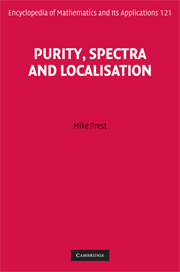Book contents
- Frontmatter
- Contents
- Preface
- Introduction
- Part I Modules
- 1 Pp conditions
- 2 Purity
- 3 Pp-pairs and definable subcategories
- 4 Pp-types and pure-injectivity
- 5 The Ziegler spectrum
- 6 Rings of definable scalars
- 7 M-dimension and width
- 8 Examples
- 9 Ideals in mod-R
- Appendix A Model theory
- Part II Functors
- Part III Definable categories
- Appendix D Model theory of modules: an update
- Appendix E Some definitions
- Main examples
- Bibliography
- Index
2 - Purity
from Part I Modules
Published online by Cambridge University Press: 05 March 2013
- Frontmatter
- Contents
- Preface
- Introduction
- Part I Modules
- 1 Pp conditions
- 2 Purity
- 3 Pp-pairs and definable subcategories
- 4 Pp-types and pure-injectivity
- 5 The Ziegler spectrum
- 6 Rings of definable scalars
- 7 M-dimension and width
- 8 Examples
- 9 Ideals in mod-R
- Appendix A Model theory
- Part II Functors
- Part III Definable categories
- Appendix D Model theory of modules: an update
- Appendix E Some definitions
- Main examples
- Bibliography
- Index
Summary
This chapter presents basic results on purity and certain kinds of modules (absolutely pure, flat, coherent). Then detailed connections between the shape of pp conditions and direct-sum decomposition of finitely presented modules, especially over RD rings, are established.
Purity
Sections 2.1.1 and 2.1.3 contain the definition of purity (of embeddings, of exact sequences, of epimorphisms) and basic results on this. Pure-projective modules are introduced in Section 2.1.2: the dual concept of pure-injectivity is the theme of Chapter 4.
Homological dimensions based on pure-exact sequences are described in Section 2.2.
For purity and pure-injectivity in more general contexts see, for example, [86], [622].
Pure-exact sequences
Purity is defined first in terms of pp conditions/solutions of systems of equations; there are other characterisations (2.1.7, 2.1.19, 2.1.28). An exact sequence is pure iff it is a direct limit of split exact sequences (2.1.4). There is a characterisation of pure epimorphisms in terms of lifting of pp conditions (2.1.14). A short exact sequence which is pure is split if its last non-zero term is finitely presented (2.1.18). Every subset of a module is contained in a pure submodule which is not too much bigger (2.1.21).
- Type
- Chapter
- Information
- Purity, Spectra and Localisation , pp. 43 - 84Publisher: Cambridge University PressPrint publication year: 2009



